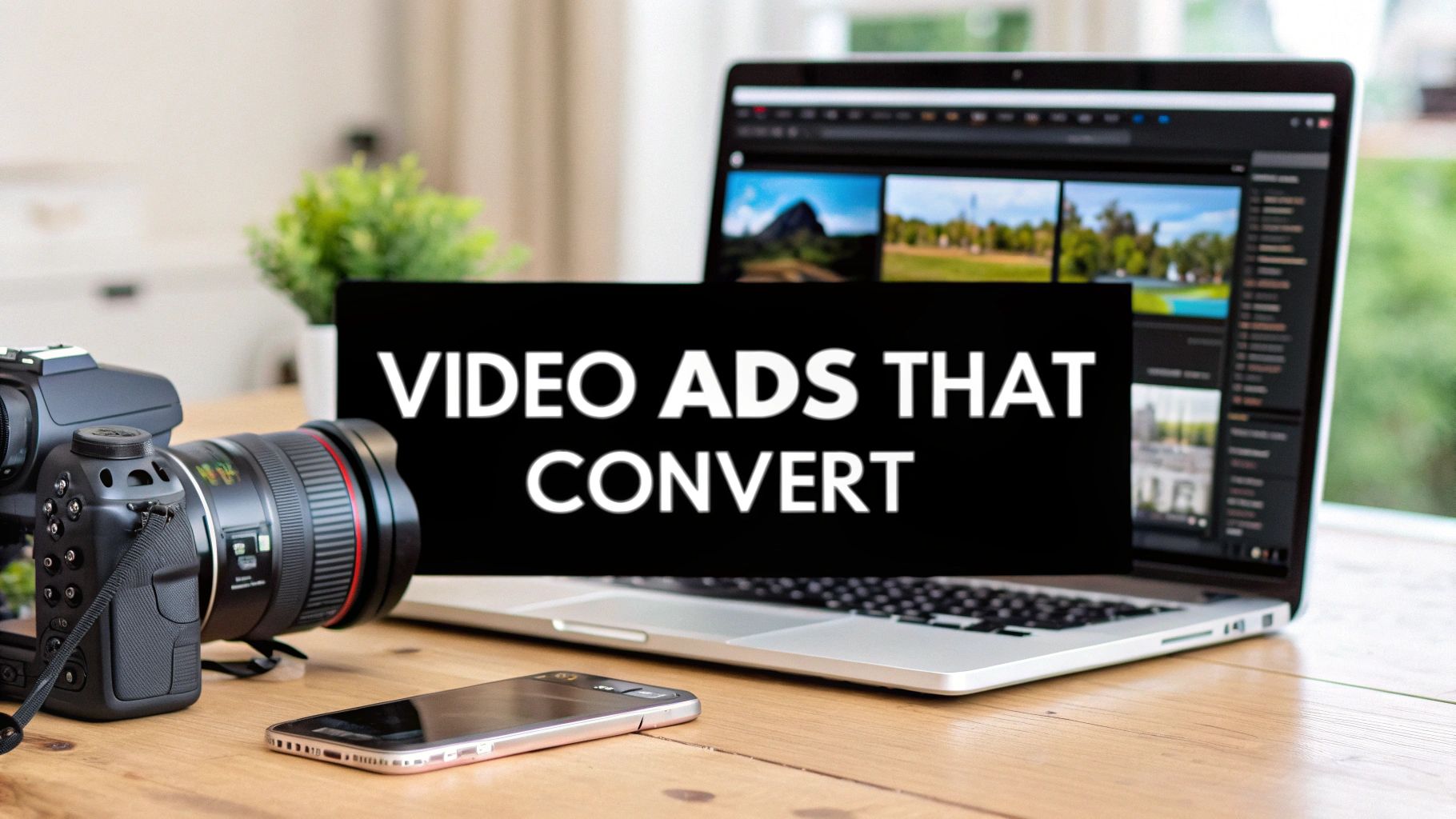
How to Make Video Ads That Convert
Learn how to make video ads that drive real results. This guide covers scripting with AI, production, and distribution for high-converting ad campaigns.
Think about the best video ad you've ever seen. What made it stick?
Chances are, it followed a simple but powerful formula: it snagged your attention with a killer hook, told a story that kept you watching, and then gave you a clear next step. That's the secret sauce. Mastering this flow is how you turn someone scrolling on their phone into your next customer.
Your Blueprint for High-Converting Video Ads
So, you're ready to create video ads that actually work. It's a crowded world out there, and making something that not only gets seen but also gets results is part art, part science. Let's break down the whole process, from that first lightbulb idea all the way to tracking your success after launch.
The Anatomy of a Winning Ad
Every great video ad, no matter the product or platform, has the same DNA. It’s a structure designed to take a viewer from "Who's this?" to "I need this."
This flow isn't just a suggestion—it's essential.
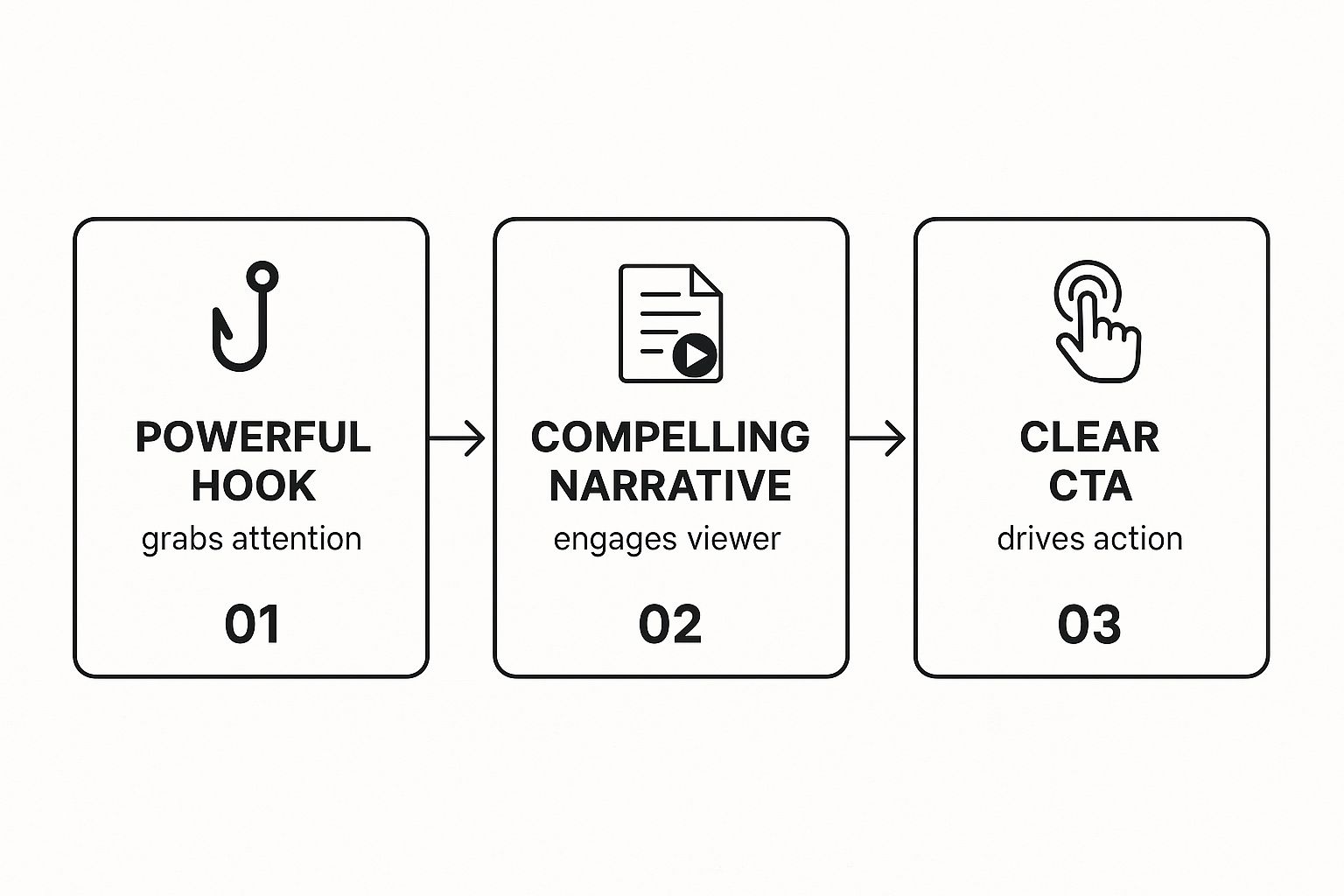
Think about it: a weak hook means no one even sees your amazing story. And a great story without a clear call-to-action is just a missed opportunity. Each piece has to build on the last.
The money is flowing toward video for a reason. Digital video ad spending in the U.S. is on track to hit a massive $72 billion, growing two to three times faster than any other media. That's a huge shift, driven by streaming and social feeds where video is king.
A great video ad doesn't just sell a product; it tells a story that solves a problem. Your goal is to make the viewer the hero and your product the tool that helps them succeed.
To give you a clearer picture, I've mapped out the entire creative journey.
The 5 Phases of Video Ad Creation at a Glance
This table breaks down the core stages you'll go through. It’s a high-level look at the process, from initial concept to the final campaign launch.
| Phase | Key Objective | Primary Tools | | :--- | :--- | :--- | | 1. Planning & Strategy | Define goals, audience, and key message. | Notion, Miro, Google Docs | | 2. Scripting & Storyboarding | Write the narrative and visualize each scene. | Jasper, Copy.ai, Canva | | 3. Production | Film original content or source stock footage. | Your camera, Synthesia, Pictory | | 4. Editing & Post-Production | Assemble the video, add effects, and polish. | Descript, CapCut, Adobe Premiere | | 5. Distribution & Analysis | Launch the ad and track its performance. | Meta Ads Manager, Google Ads |
Seeing it laid out like this helps you stay organized and ensure you don't miss a critical step along the way.
Of course, creating the ad is only half the battle. You need to know if it's actually working. Diving into expert strategies for measuring advertising effectiveness is non-negotiable. After all, what’s the point if you can't track your ROI?
Ultimately, this all comes back to turning views into value. For a deeper dive into that, check out our guide on https://viewprinter.tech/blog/articles/conversion-rate-optimization-tips. Think of this as your roadmap—let's get started.
Planning and Scripting Your Ad with AI
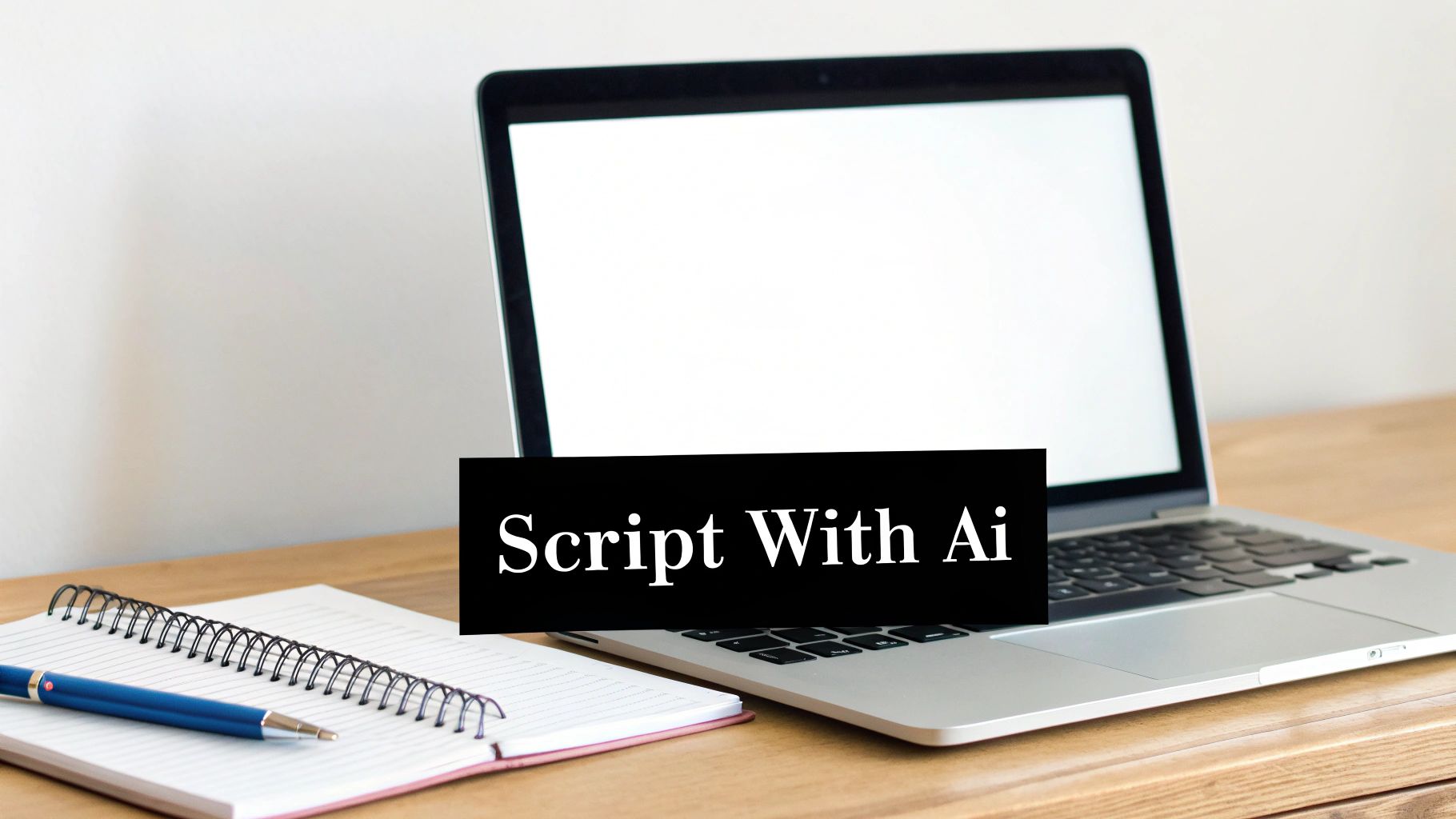
A great video ad is won or lost long before you hit record. It all comes down to the planning and scripting—that’s where you turn a cool idea into a real story that actually connects with people and serves a business goal.
Before you write a single word, you need to be crystal clear on three things: who you're talking to, what you want them to do, and what feeling you want them to walk away with. If you try to talk to everyone, you’ll end up connecting with no one.
Using AI to Beat the Blank Page
We’ve all been there, staring at a blank page. It’s intimidating. This is exactly where AI tools can step in as a creative partner, helping you brainstorm angles and spit out initial drafts in minutes.
The trick is to avoid generic prompts like "write me a video ad script." To get something truly useful, you have to give the AI specific, detailed context. Think of it less like a magic box and more like briefing a junior copywriter.
Here’s a prompt structure that I’ve found works wonders:
- Role: "Act as an expert direct-response copywriter who specializes in short-form video ads for e-commerce brands."
- Product: "The product is 'Solana,' a portable, solar-powered phone charger designed for outdoor enthusiasts."
- Audience: "Our target audience is hikers and campers, ages 25-40, who care about sustainability and need to stay connected while off-grid."
- Goal: "The primary goal is to drive traffic to the product page and get pre-orders."
- Task: "Write three different 30-second video ad scripts. Each one needs to follow the Hook-Problem-Solution-CTA framework. The tone should feel adventurous and inspiring."
This level of detail gives the AI the guardrails it needs to create something genuinely helpful. You’ll get multiple creative directions to work from, saving you hours of brainstorming.
Tailoring Your Message for Different Platforms
A script for YouTube won't work on TikTok. You can't just copy and paste. The pacing, the style, the entire structure needs to change. Today, video makes up a massive 82% of all consumer internet traffic, and most of that is short-form. You have seconds, not minutes, to grab someone's attention.
So, how do you adapt? Take the best script from your first AI generation and feed it right back in with a new instruction.
Pro Tip: Try a prompt like this: "Now, adapt the first script for a TikTok ad. Make the pacing much faster, add suggestions for text overlays on key points, and recommend a trending audio track that fits the adventurous vibe. Keep the total video under 20 seconds."
This back-and-forth process lets you quickly create content that feels native to each platform, instead of looking like a repurposed ad that just doesn't belong.
If you’re still honing your skills, looking at a great advertising script example can show you what a finished product looks like. And remember, even with AI in your corner, understanding the fundamentals of how to write a script for video is still what separates a good ad from a great one.
Ultimately, think of AI as your co-pilot. It’s there to speed up the brainstorming and drafting, but the final script needs your human touch. That’s what adds the authenticity and emotion that actually makes people click. Use the tools to build the foundation, then make it yours.
Producing Your Video Content on Any Budget
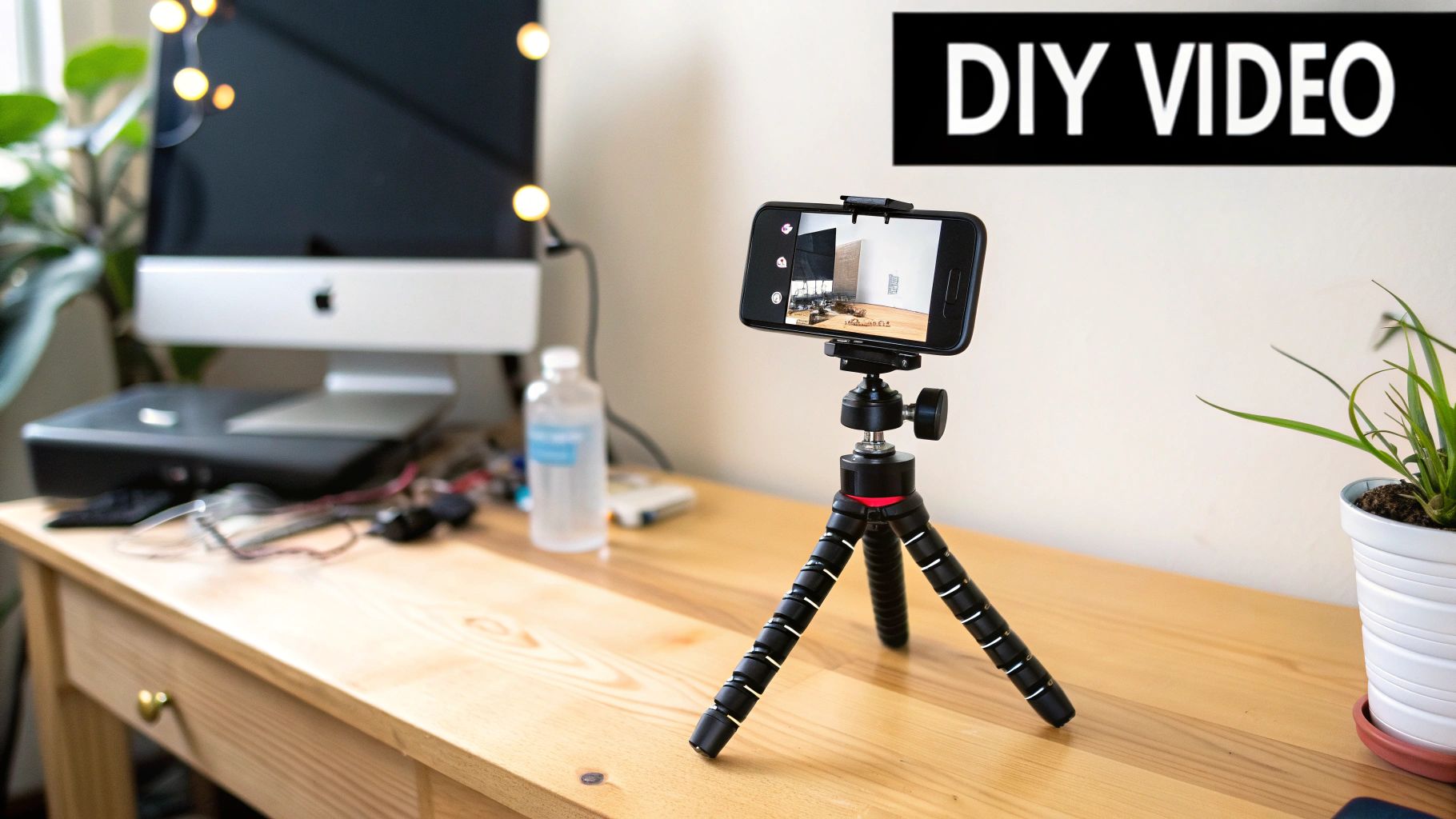
With a sharp script ready to go, it's time to bring your video ad to life. This is the part that often feels like it's going to break the bank, but creating a professional-looking video is more accessible today than ever before. You don't need a Hollywood-sized budget; you just need to be smart about your resources.
Whether you're shooting on your iPhone or hiring a small crew, the core principles don't change. The goal is always to capture clean visuals and, most importantly, crystal-clear audio. Viewers will forgive slightly imperfect lighting, but they will instantly click away from a video with muffled or distorted sound. It’s an absolute deal-breaker.
The Scrappy DIY Approach
For most small businesses and startups, a do-it-yourself setup is the perfect place to start. Your modern smartphone is already a ridiculously powerful 4K camera. The real difference-makers are the things you put around it: lighting and audio. And thankfully, upgrading them is surprisingly affordable.
A simple setup can make a massive impact on quality:
- Invest in a lavalier microphone. A wired or wireless mic that clips onto your shirt can cost as little as $20. It will dramatically improve your audio quality over your phone's built-in mic, which is designed to pick up everything in the room.
- Use a ring light or softbox. Good lighting is what makes footage look crisp and professional. A basic ring light can eliminate harsh shadows and create a flattering look for under $50.
- Find a quiet, clean location. Choose a space with minimal background noise and a simple, uncluttered backdrop. You want the focus to be on your message, not the messy bookshelf behind you.
This tiny investment can elevate your self-shot video from looking amateur to polished and credible. It’s a small price to pay for a massive leap in perceived quality.
Knowing When to Hire a Professional
As your business grows—or when you're launching a flagship campaign—hiring a professional videographer or a small production company is a worthwhile investment. You’re not just paying for better equipment; you’re paying for expertise in storytelling, lighting, and directing.
Consider hiring a pro when your concept involves complex shots, multiple locations, or professional actors. Their experience can save you a ton of time and deliver a final product that a DIY setup simply can't match, ultimately driving better results for your campaign.
The Power of Stock Footage and AI
But what if you don't need to film anything at all?
An increasingly popular way to create high-impact video ads is by using high-quality stock footage or AI-generated visuals. Platforms like Artgrid or Storyblocks offer millions of cinematic clips you can license for a simple monthly fee.
This approach is perfect for ads that need to show diverse locations, lifestyle scenarios, or abstract concepts that would be impossible to film on a small budget. Many AI video generators can even turn a single product image into a dynamic, multi-scene video.
By combining these visual assets with a strong voiceover and clear text overlays, you can produce stunning ads without ever touching a camera. It’s a total game-changer for speed and cost-effectiveness.
Editing Your Ad with Modern Tools
Once the cameras are off, the real magic begins. The editing suite is where raw footage, audio clips, and graphics are meticulously pieced together to tell a persuasive story. While editing can feel like a daunting technical hurdle, today's tools have made it more accessible than ever before.
Your first move is usually creating an "assembly cut." This is just a fancy way of saying you’re arranging your clips in the right order to follow your script. Don't get hung up on perfect timing just yet; the goal here is to get the basic skeleton of your ad in place. Think of it as a rough draft before you start polishing.
Choosing Your Editing Software
The software you choose can range from surprisingly powerful free options to the subscription-based giants the pros use. The right choice really boils down to your budget, your experience level, and how complex your ad needs to be. There’s no single "best" tool, only the one that best fits your workflow.
If you're just starting out or working with a lean budget, tools like CapCut (on mobile) or DaVinci Resolve (on desktop) are incredible. They're free and pack more than enough punch for trimming clips, adding text, and tweaking audio. As you get more ambitious, you might look into professional-grade software like Adobe Premiere Pro or Final Cut Pro for their deeper feature sets and integrations.
Editing isn't just about slicing and dicing clips. It's about controlling the rhythm and feel of your ad. A series of quick cuts can inject energy and excitement, while a longer, slower shot can build a more emotional connection. Your timing guides how the audience feels.
If you're stuck trying to pick a platform, our detailed breakdown of the best video editing software for social media can help you weigh the pros and cons. Making a smart choice here can save you a ton of frustration later on.
Polishing Your Ad for Professional Quality
With your clips lined up, it's time to add the layers that give your video that professional sheen. These small details are often what separates a homemade-looking ad from a polished, high-performing one. This is a critical step in learning how to make video ads that actually get results.
These key enhancements are where your ad truly comes to life:
- Music and Sound Effects: The right soundtrack is a shortcut to emotion. Find a track that matches the vibe you're going for, whether it's upbeat and energetic or calm and reassuring. Don't forget subtle sound effects—they can make on-screen actions feel more real and satisfying.
- Text and Graphics: Use text overlays to hammer home your main message or your call-to-action. On platforms where people often watch with the sound off (which is most of them!), clear, bold text is an absolute must.
- Simple Color Correction: You don’t need to be a Hollywood colorist to make your visuals pop. Almost all editing software has basic tools to adjust brightness, contrast, and saturation. A few tiny tweaks can make your footage look way more vibrant and consistent.
- Audio Mixing: Last but not least, make sure your audio levels are balanced. The background music shouldn't be fighting with your voiceover, and sound effects should add to the experience, not distract from it. Your goal is clean, clear audio that’s easy to understand.
By focusing on these four areas, you’ll end up with a final video that looks and sounds like it was made by a pro, grabbing attention and driving the action you're after.
Distributing and Promoting Your Video Ad
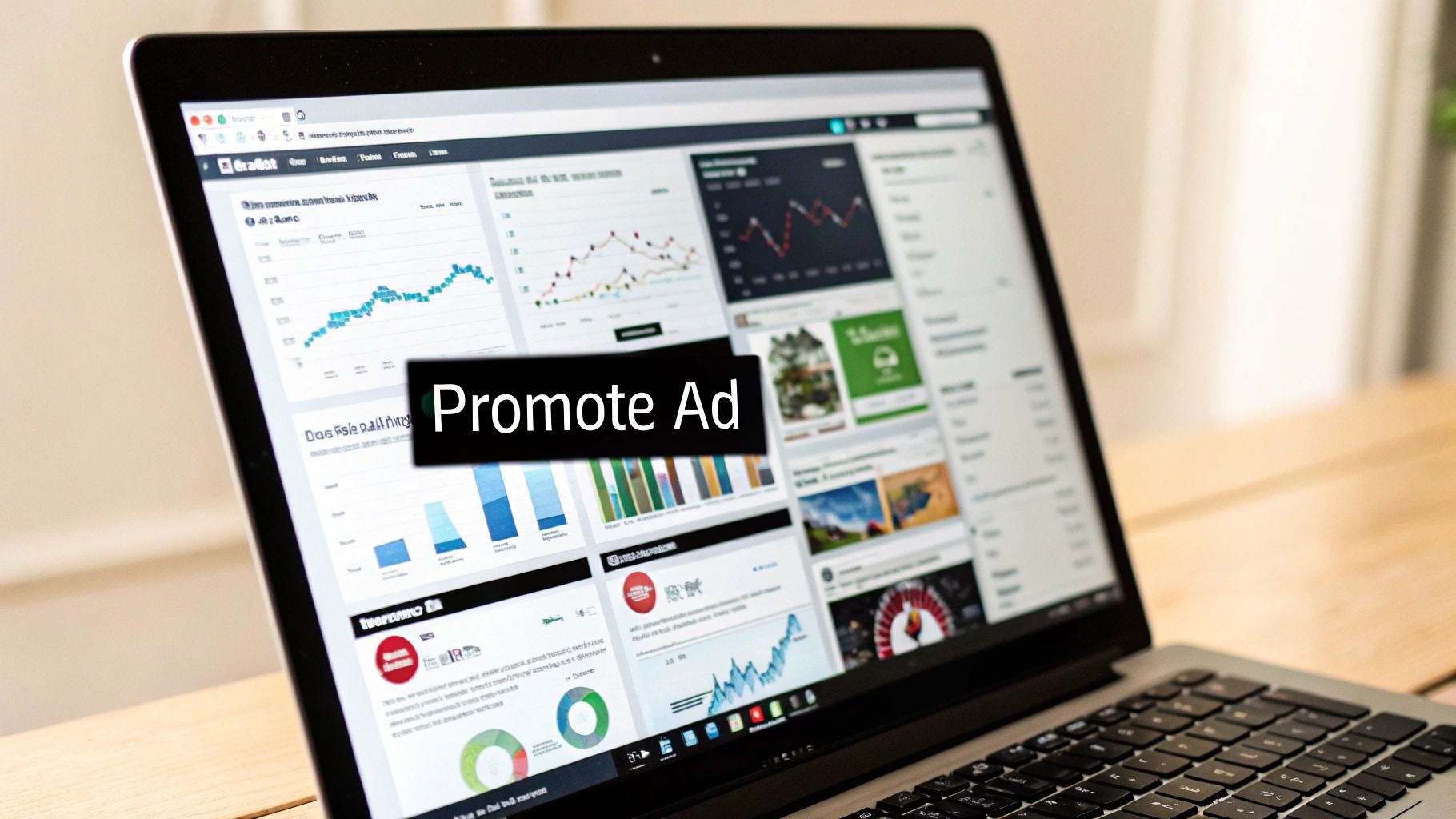
You’ve created a polished, persuasive video ad. That’s a huge win, but the job isn't done. A brilliant ad is completely useless if your ideal customer never sees it.
Now, it’s time to switch hats from creator to strategist and get your video in front of the right eyeballs. This is where a smart distribution plan turns your creative work into a revenue-generating machine.
This phase is a massive part of the process. Video marketing has become absolutely central to business growth, with a staggering 89% of companies now using it as a primary marketing tool. The real challenge isn’t just making a video; it’s getting it seen. You can dig deeper into the numbers with these video marketing statistics.
Choosing the Right Ad Platforms
Not all social media platforms are created equal. Where you run your ad matters just as much as what's in it.
Let your audience's behavior be your guide. Are they professionals networking on LinkedIn, teens discovering trends on TikTok, or hobbyists learning new skills on YouTube? Your choice of channel dictates everything from your ad format to your budget.
- Meta (Facebook & Instagram): Unbeatable for its incredibly detailed demographic and interest-based targeting. It's a goldmine for e-commerce brands and any business targeting specific life stages or hobbies.
- TikTok: The undisputed king of short-form, trend-driven content. Perfect for brands targeting a younger audience with authentic, entertaining, and low-fi video ads.
- YouTube: It’s the world's second-largest search engine, not just a video site. It's best for in-stream ads that grab attention in seconds and for targeting users based on their search history and viewing habits.
- LinkedIn: This is the go-to for all things B2B. Use it to target professionals by job title, industry, or company size with content that solves a problem or establishes you as a thought leader.
My advice? Don't spread your budget too thin by trying to be everywhere at once. Start with the one or two platforms where you know your ideal customers are most active and engaged. Master those first.
Setting Up Your Campaign for Success
Once you’ve picked your platform, it’s time to actually build your campaign. This means setting a clear objective, defining your audience with surgical precision, and allocating a budget.
Your campaign objective tells the platform's algorithm exactly what you want to achieve—is it website traffic? Lead generation? Direct sales? Be specific.
Next, you'll build your audience. Go way beyond basic demographics. Layer in interests, online behaviors, and lookalike audiences. For example, a company selling sustainable hiking gear could target users interested in "national parks," who follow outdoor brands, and who have made online purchases in the past month.
A well-targeted ad shown to 1,000 ideal customers will always outperform a generic ad shown to 100,000 random people. Precision beats reach every single time.
Tracking and Optimizing Performance
Launching your ad isn't the finish line; it’s the starting pistol for optimization. You have to track key metrics to understand what's working and, more importantly, what isn't. The most successful campaigns are built on a foundation of constant testing and refinement.
Start by running a simple A/B test. This just means creating two versions of your ad with one small difference. Maybe one has a different opening hook, a different call-to-action, or even different background music. By running both at the same time, you let the data—not your gut—tell you which one resonates more.
Keep a close eye on these critical metrics:
- Click-Through Rate (CTR): The percentage of people who see your ad and actually click on it.
- Conversion Rate: The percentage of those clickers who complete the action you wanted (like making a purchase).
- Cost Per Acquisition (CPA): How much you're actually paying for each new customer.
By monitoring these numbers, you can turn off the ads that are burning cash, double down on the winners, and steadily improve your return on investment. This data-driven approach is how you learn to make video ads that don't just get views—they build your business.
Got Questions About Making Video Ads?
As you dive into creating video ads, you’re bound to have some questions. It’s a world with a lot of moving parts, but honestly, most of the common hurdles have pretty straightforward solutions.
Getting these things cleared up now will save you a ton of time, cash, and headaches later on. Let's walk through some of the biggest questions that trip up creators and marketers so you can move forward with confidence.
How Long Should My Video Ad Actually Be?
There's no magic number here. The right length depends entirely on the platform you're on and what you're trying to achieve. Think about it: the mindset of someone scrolling TikTok is completely different from someone deep-diving into a product review on YouTube. Context is everything.
You need to match your ad's length to how people behave on each platform:
- TikTok & Instagram Reels: Go short and snappy. You've got about 15-30 seconds to make an impact before they swipe away.
- YouTube Pre-Roll Ads: Those first 5-15 seconds are gold, especially before that "skip" button pops up. Your hook has to land, and it has to land fast.
- Landing Pages or Your Website: Here, you have a bit more breathing room. A 60-90 second explainer video can do wonders for a more complex product or service.
When in doubt, test it out. Run a 15-second version against a 30-second one and see what the data says. Your audience will tell you what they prefer.
What Are the Most Common Rookie Mistakes I Should Avoid?
So many beginners stumble over the same few things when they start making video ads. The good news? They're all easy to sidestep once you know what to look for. Just getting these fundamentals right will put you way ahead of the curve.
The biggest mistake I see is creating a video that feels too much like a slick, old-school TV commercial. Audiences today, especially on social media, crave authenticity. A real story that solves a real problem will beat a polished list of product features every single time.
Here are the top three pitfalls to watch out for:
- Bad Audio Quality: This is the #1 reason people scroll past an ad. If your audio is muffled, staticky, or too quiet, you've already lost them. A simple lavalier microphone is a cheap investment that pays for itself on day one.
- No Call-to-Action (CTA): You did it! You hooked them and told a great story... but now what? You have to tell people what to do next. End every ad with a clear, direct command like "Shop Now," "Learn More," or "Download the App." If you don't ask, you don't get.
- Wasting the First Three Seconds: Your opening is everything. Don't start with a slow, boring logo animation. Jump straight into the action, hit them with a problem, or ask a question that makes them stop and think.
Do I Really Need Expensive Equipment to Get Started?
Absolutely not. That phone in your pocket probably shoots in crisp 4K, which is more than enough for a high-quality video ad. The myth that you need a multi-thousand-dollar camera setup holds way too many people back.
Honestly, your money is much better spent on two things that have a far bigger impact: good lighting and clear audio. A simple ring light can make you look great by getting rid of harsh shadows, and a decent microphone ensures your message comes through loud and clear.
At the end of the day, a strong script and a clear message will always be more important than the camera you used to film it. Start small, nail the basics, and you can always upgrade your gear as you grow.
Ready to create high-converting video ads without the guesswork? ViewPrinter gives you the AI tools to generate stunning visuals, write compelling scripts, and even build dynamic slideshows in seconds. Ditch the complexity and start producing content that gets results.